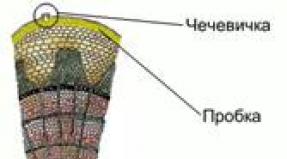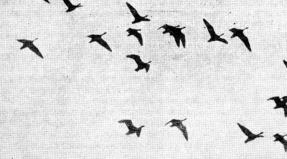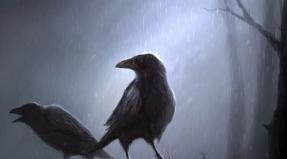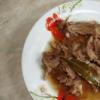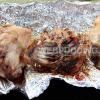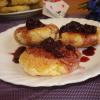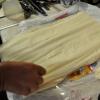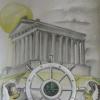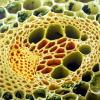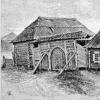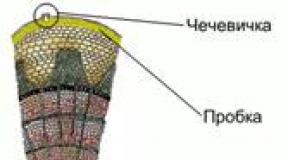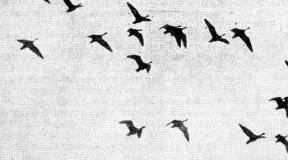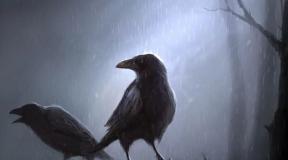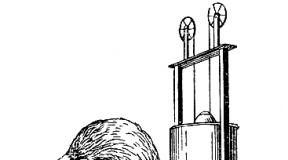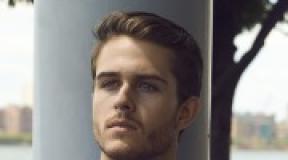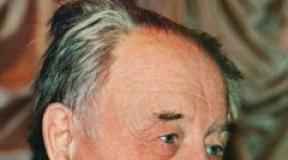Parade of military equipment on Red Square 1945. Victory Day: little-known facts about one of the most significant holidays in the country
Today is June 24, on this day 71 years ago, the historical Victory Parade took place in Moscow, on Red Square, to commemorate the victory of the USSR over Germany in the Great Patriotic War.
At 10 o'clock in the morning, Marshal of the Soviet Union Georgy Zhukov rode on a white horse from the Spassky Gate to Red Square in Moscow. After the command “Parade, attention!” The square exploded with a roar of applause. The commander of the parade, Konstantin Rokossovsky, presented a report to Georgy Zhukov, and then together they began to tour the troops. Following this, the signal “Listen, everyone!” sounded, and the military orchestra played the anthem “Hail, Russian people!” Mikhail Glinka. After Zhukov's welcoming speech, the anthem of the Soviet Union was played, and the solemn march of the troops began.
The parade was attended by combined regiments from each front operating at the end of the war, as well as military academies, military schools and units of the Moscow garrison. The regiments included Heroes of the Soviet Union, holders of the Order of Glory, famous snipers and the most distinguished order bearers. In addition, there were infantry, artillerymen, tank crews and pilots, cavalrymen, sappers and signalmen. 36 battle flags of the most distinguished formations and units in battle were carried by specially trained standard bearers with assistants.
The Red Banner of Victory was also brought from Berlin, which was hoisted over the Reichstag. Following the regiments of the fronts and the Navy, a combined column of Soviet soldiers entered Red Square, carrying 200 banners of the Nazi troops, defeated on the battlefields, lowered to the ground. Under the beating of drums, these banners were thrown to the foot of the Mausoleum.
The decision to hold a parade in honor of the victory over Germany was made by Supreme Commander-in-Chief Joseph Vissarionovich Stalin shortly after Victory Day - in mid-May 1945. Deputy Chief of the General Staff, Army General S.M. Shtemenko recalled: “The Supreme Commander-in-Chief ordered us to think over and report to him our thoughts on the parade to commemorate the victory over Nazi Germany, and indicated: “We need to prepare and hold a special parade. Let representatives of all fronts and all branches of the military take part in it..."
On May 24, 1945, the General Staff presented Joseph Stalin with its considerations for holding a “special parade.” The Supreme Commander accepted them, but postponed the date of the parade. The General Staff asked for two months to prepare. Stalin gave instructions to hold the parade in a month. On the same day, the commanders of the Leningrad, 1st and 2nd Belorussian, 1st, 2nd, 3rd and 4th Ukrainian Fronts received a directive from the Chief of the General Staff, Army General Alexei Innokentyevich Antonov, to hold a parade:
The Supreme Commander-in-Chief ordered:
1. To participate in the parade in the city of Moscow in honor of the victory over Germany, select a consolidated regiment from the front.
2. Form the consolidated regiment according to the following calculation: five two-company battalions of 100 people in each company (ten squads of 10 people). In addition, 19 command personnel consisting of: regiment commander - 1, deputy regiment commander - 2 (combatant and political), regimental chief of staff - 1, battalion commanders - 5, company commanders - 10 and 36 flag bearers with 4 assistant officers. In total there are 1059 people in the combined regiment and 10 reserve people.
3. In a consolidated regiment, have six companies of infantry, one company of artillerymen, one company of tank crews, one company of pilots and one composite company (cavalrymen, sappers, signalmen).
4. The companies should be staffed so that the squad commanders are mid-level officers, and in each squad there are privates and sergeants.
5. Personnel to participate in the parade shall be selected from among the soldiers and officers who have most distinguished themselves in battle and have military orders.
6. Arm the combined regiment with: three rifle companies - with rifles, three rifle companies - with machine guns, a company of artillerymen - with carbines on their backs, a company of tankers and a company of pilots - with pistols, a company of sappers, signalmen and cavalrymen - with carbines on their backs, cavalrymen, in addition - checkers.
7. The front commander and all commanders, including the aviation and tank armies, arrive at the parade.
8. The consolidated regiment arrive in Moscow on June 10, 1945, with 36 combat banners, the most distinguished formations and units of the front in battles, and all enemy banners captured in battle, regardless of their number.
9. Ceremonial uniforms for the entire regiment will be issued in Moscow.
Defeated standards of Hitler's troops
Ten combined regiments of the fronts and a combined regiment of the Navy were supposed to participate in the festive event. Students of military academies, cadets of military schools and troops of the Moscow garrison, as well as military equipment, including aircraft, were also involved in the parade. At the same time, the troops that existed as of May 9, 1945 of seven more fronts of the USSR Armed Forces did not take part in the parade: Transcaucasian Front, Far Eastern Front, Transbaikal Front, Western Air Defense Front, Central Air Defense Front, Southwestern Air Defense Front and Transcaucasian Air Defense Front.
The troops immediately began creating consolidated regiments. The fighters for the country's main parade were meticulously selected. First of all, they took those who showed heroism, courage and military skill in battles. Qualities such as height and age mattered. For example, the order for the troops of the 1st Belorussian Front dated May 24, 1945 stated that height should be no lower than 176 cm, and age no older than 30 years.
At the end of May the regiments were formed. According to the order of May 24, the combined regiment was supposed to have 1059 people and 10 reserve people, but in the end the number was increased to 1465 people and 10 reserve people. The commanders of the combined regiments were determined to be:
- from the Karelian Front - Major General G. E. Kalinovsky;
- from Leningradsky - Major General A. T. Stupchenko;
- from the 1st Baltic - Lieutenant General A.I. Lopatin;
- from the 3rd Belorussian - Lieutenant General P.K. Koshevoy;
- from the 2nd Belorussian - Lieutenant General K. M. Erastov;
- from the 1st Belorussian - Lieutenant General I.P. Rosly;
- from the 1st Ukrainian - Major General G.V. Baklanov;
- from the 4th Ukrainian - Lieutenant General A. L. Bondarev;
- from the 2nd Ukrainian - Guard, Lieutenant General I. M. Afonin;
- from the 3rd Ukrainian - Guard, Lieutenant General N.I. Biryukov;
- from the Navy - Vice Admiral V. G. Fadeev.
The Victory Parade was hosted by Marshal of the Soviet Union Georgy Konstantinovich Zhukov. The parade was commanded by Marshal of the Soviet Union Konstantin Konstantinovich Rokossovsky. The entire organization of the parade was led by the commander of the Moscow Military District and the head of the Moscow garrison, Colonel General Pavel Artemyevich Artemyev.
Marshal G.K. Zhukov accepts the Victory Parade in Moscow
During the organization of the parade, a number of problems had to be solved in a very short time. So, if students of military academies, cadets of military schools in the capital and soldiers of the Moscow garrison had ceremonial uniforms, then thousands of front-line soldiers needed to sew them. This problem was solved by garment factories in Moscow and the Moscow region. And the responsible task of preparing ten standards, under which the combined regiments were to march, was entrusted to a unit of military builders. However, their project was rejected. In an emergency, we turned to specialists from the Bolshoi Theater art and production workshops for help.
The head of the art and props shop, V. Terzibashyan, and the head of the metalworking and mechanical shop, N. Chistyakov, coped with the assigned task. A horizontal metal pin with “golden” spiers at the ends was attached to a vertical oak shaft with a silver wreath, which framed a gold five-pointed star. On it hung a double-sided scarlet velvet panel of the standard, bordered with gold patterned hand lettering and with the name of the front. Individual heavy golden tassels fell along the sides. This sketch was accepted.
Hundreds of order ribbons, which crowned the staffs of 360 battle flags, which were carried at the head of the combined regiments, were also made in the workshops of the Bolshoi Theater. Each banner represented a military unit or formation that had distinguished itself in battle, and each of the ribbons commemorated a collective feat, marked by a military order. Most of the banners were guards.
By June 10, special trains carrying parade participants began arriving in the capital. In total, 24 marshals, 249 generals, 2,536 officers, 31,116 privates and sergeants took part in the parade. Hundreds of military equipment were prepared for the parade. The training took place at the Central Airfield named after M.V. Frunze. Soldiers and officers trained for 6-7 hours every day. And all this for the sake of three and a half minutes of immaculate march across Red Square. The parade participants were the first in the army to be awarded the medal “For Victory over Germany in the Great Patriotic War of 1941-1945,” established on May 9, 1945.
At the direction of the General Staff, about 900 units of captured banners and standards were delivered to Moscow from Berlin and Dresden. Of these, 200 banners and standards were selected and placed under guard in a special room. On the day of the parade, they were taken in covered trucks to Red Square and handed over to the soldiers of the parade company of “porters.” Soviet soldiers carried enemy banners and standards with gloves, emphasizing that it was disgusting to even hold the poles of these symbols in your hands. At the parade, they will be thrown onto a special platform so that the standards do not touch the pavement of the sacred Red Square. Hitler's personal standard will be thrown first, the last - the banner of Vlasov's army. Later this platform and gloves will be burned.
The parade was planned to begin with the removal of the Victory Banner, which was delivered to the capital on June 20 from Berlin. However, the standard bearer Neustroyev and his assistants Egorov, Kantaria and Berest, who hoisted it above the Reichstag and sent to Moscow, went extremely poorly at the rehearsals. During the war there was no time for drill training. The same battalion commander of the 150th Idritso-Berlin Rifle Division, Stepan Neustroev, had several wounds and his legs were damaged. As a result, they refused to carry out the Victory Banner. By order of Marshal Zhukov, the banner was transferred to the Central Museum of the Armed Forces. The Victory Banner was brought to the parade for the first time in 1965.
Victory parade. Standard bearers
Victory parade. Formation of sailors
Victory parade. Formation of tank officers
Kuban Cossacks
On June 22, 1945, order No. 370 of the Supreme Commander-in-Chief was published in the central newspapers of the Union:
Order of the Supreme Commander-in-Chief
« To commemorate the victory over Germany in the Great Patriotic War, I appoint a parade of troops of the active army, the Navy and the Moscow garrison on June 24, 1945 in Moscow on Red Square - the Victory Parade.
Bring the combined front regiments, the combined regiment of the People's Commissariat of Defense, the combined regiment of the Navy, military academies, military schools and troops of the Moscow garrison to the parade.
The Victory Parade will be hosted by my Deputy Marshal of the Soviet Union Zhukov.
Command the Victory Parade to Marshal of the Soviet Union Rokossovsky.
I entrust general leadership for organizing the parade to the commander of the Moscow Military District and the head of the garrison of the city of Moscow, Colonel General Artemyev.”
Supreme Commander
Marshal of the Soviet Union I. Stalin.
The morning of June 24 turned out to be rainy. Fifteen minutes before the parade started, it started to rain. The weather improved only in the evening. Because of this, the aviation part of the parade and the passage of Soviet workers were canceled. At exactly 10 o'clock, with the Kremlin chimes striking, Marshal Zhukov rode out onto Red Square on a white horse. At 10:50 a.m. the troop detour began. The Grand Marshal alternately greeted the soldiers of the combined regiments and congratulated the Parade participants on the victory over Germany. The troops responded with a mighty “Hurray!”
Having toured the regiments, Georgy Konstantinovich rose to the podium. The Marshal congratulated the Soviet people and their valiant armed forces on their victory. Then the USSR anthem was played, performed by 1,400 military musicians, 50 artillery salutes thundered, and three times the Russian “Hurray!” echoed over the square.
The ceremonial march of the victorious soldiers was opened by the commander of the parade, Marshal of the Soviet Union Rokossovsky. He was followed by a group of young drummers, students of the 2nd Moscow Military Music School. Behind them came the consolidated regiments of the fronts in the order in which they were located during the Great Patriotic War, from north to south. The first was the regiment of the Karelian Front, then the Leningrad, 1st Baltic, 3rd Belorussian, 2nd Belorussian, 1st Belorussian (there was a group of soldiers of the Polish Army), 1st Ukrainian, 4th Ukrainian, 2nd th Ukrainian and 3rd Ukrainian fronts. The combined regiment of the Navy brought up the rear of the solemn procession.
The movement of the troops was accompanied by a huge orchestra of 1,400 people. Each combined regiment marches through its own battle march almost without pause. Then the orchestra fell silent and 80 drums beat in silence. A group of soldiers appeared carrying 200 lowered banners and standards of the defeated German troops. They threw banners onto the wooden platforms near the Mausoleum. The stands exploded with applause. It was an act full of sacred meaning, a kind of sacred rite. The symbols of Hitler’s Germany, and therefore of “European Union 1,” were defeated. Soviet civilization has proven its superiority over the West.
After this the orchestra started playing again. Units of the Moscow garrison, a combined regiment of the People's Commissariat of Defense, students of military academies and cadets of military schools marched across Red Square. Closing the march were students of the Suvorov schools, the future of the victorious Red Empire.
Then a combined cavalry brigade led by Lieutenant General N. Ya. Kirichenko trotted past the stands, and crews of anti-aircraft guns on vehicles, batteries of anti-tank and large-caliber artillery, guards mortars, motorcyclists, armored vehicles, and vehicles with paratroopers passed by. The parade of equipment was continued by the best tanks of the Great Patriotic War, T-34 and IS, and self-propelled artillery units. The parade ended on Red Square with the march of the combined orchestra.
IS-2 tanks before entering Red Square
Heavy tanks IS-2 pass through Red Square during the parade in honor of the Victory on June 24, 1945
The parade lasted 2 hours in heavy rain. However, this did not bother people and did not spoil the holiday. The orchestras played and the celebration continued. Late in the evening the fireworks began. At 23:00, out of 100 balloons raised by anti-aircraft gunners, 20 thousand missiles flew in volleys. Thus ended this great day. On June 25, 1945, a reception was held in the Grand Kremlin Palace in honor of the participants of the Victory Parade.
It was a real triumph of the victorious people, of Soviet civilization. The Soviet Union survived and won the most terrible war in human history. Our people and army defeated the most effective military machine in the Western world. They destroyed the terrible embryo of the “New World Order” - the “Eternal Reich”, in which they planned to destroy the entire Slavic world and enslave humanity. Unfortunately, this victory, like others, did not last forever. New generations of Russian people will again have to stand in the fight against world evil and defeat it.
As Russian President V. Putin quite rightly noted in his written address addressed to visitors to the exhibition “Victory Parade on June 24, 1945,” which opened at the State Historical Museum on the eve of the 55th anniversary of the Victory Parade:
« We must not forget about this strong parade. Historical memory is the key to a worthy future for Russia. We must adopt the main thing from the heroic generation of front-line soldiers - the habit of winning. This habit is very necessary in our peaceful life today. It will help the current generation build a strong, stable and prosperous Russia. I am confident that the spirit of the Great Victory will continue to preserve our Motherland in the new, 21st century».
“We must not forget about this strong parade. Historical memory is the key to a worthy future for Russia. We must adopt the main thing from the heroic generation of front-line soldiers - the habit of winning. This habit is very necessary in our peaceful life today. It will help the current generation build a strong, stable and prosperous Russia. I am confident that the spirit of the Great Victory will continue to preserve our Motherland in the new, 21st century.” Vladimir Putin.
There are many myths, facts and legends associated with the history of the First Military Parade on Red Square to commemorate the victory of the USSR over Germany in the Great Patriotic War. Even before the parade, from the very idea, this event was given the status: “Special Parade.” This is how he is remembered in the history of Russia - special not only in concept, but also in fact.
So, the facts about the first military parade on Red Square in 1945.
1. "Special Parade"
The decision to hold a parade of winners was made by I.V. Stalin shortly after Victory Day - May 15, 1945. Deputy Chief of the General Staff, Army General S.M. Shtemenko recalled: “The Supreme Commander-in-Chief ordered us to think over and report to him our thoughts on the parade to commemorate the victory over Nazi Germany, and indicated: “We need to prepare and hold a special parade. Let representatives of all fronts and all branches of the military take part in it...”
Already on May 24 I.V. Stalin was informed of the General Staff's proposals for holding the Victory Parade. He accepted them, but did not agree with the timing. While the General Staff allowed two months for preparations, Stalin ordered the parade to be held in a month. On the same day, preparations began for the most important historical holiday of all generations.
2. "The Fall of Stalin"
The order to hold the Victory Parade was published in all Soviet central newspapers 2 days before the event itself, and to the surprise of many, the order stated that the Parade would be hosted not by the Supreme Commander-in-Chief, but by Marshal Zhukov: “The Victory Parade will be hosted by my deputy Marshal of the Soviet Union Zhukov . Command the Victory Parade to Marshal of the Soviet Union Rokossovsky.” The truth why the leader refused to accept the Parade in person was revealed only a year later - in the memoirs of Georgy Konstantinovich Zhukov, “Memories and Reflections.” And this is what happened:
A week before the parade day, Stalin called Zhukov to his dacha and asked if the marshal had forgotten how to ride a horse. He has to drive staff cars more and more. Zhukov replied that he had not forgotten how to do it and in his spare time he tried to ride a horse.
“That’s it,” said the Supreme Commander, “you will have to host the Victory Parade.” Rokossovsky will command the parade.
Zhukov was surprised, but didn’t show it:
– Thank you for such an honor, but wouldn’t it be better for you to host the parade?
And Stalin told him:
“I’m too old to host parades.” Take it, you are younger.
The next day, Zhukov went to the Central Airfield on the former Khodynka - a parade rehearsal was taking place there - and met with Vasily, Stalin’s son. And it was here that Vasily amazed the marshal. He told me in confidence that my father himself was going to host the parade. I ordered Marshal Budyonny to prepare a suitable horse and went to Khamovniki, to the main army riding arena on Chudovka, as Komsomolsky Prospekt was called then. There, the army cavalrymen set up their magnificent arena - a huge, high hall, covered in large mirrors.
It was here that Stalin came on June 16, 1945 to shake off the old days and check whether the horseman’s skills had not been lost over time. At a sign from Budyonny, they brought the snow-white horse and helped Stalin into the saddle. Budyonny then said: “This one is the calmest.”
Having collected the reins in his left hand, which always remained bent at the elbow and only half active, which is why the evil tongues of his party comrades called the leader “Sukhorukiy”, Stalin spurred the restive horse - and it rushed from its place... The rider fell out of the saddle and, despite onto a thick layer of sawdust, he hit his side and head painfully... Everyone rushed to him and helped him up. Budyonny, a timid man, looked at the leader with fear... But there were no consequences.
However, there is an opinion that this episode is falsified.

3. Total number of Parade participants
24 marshals, 249 generals, 2,536 officers, 31,116 sergeants and soldiers took part in the Victory Parade on June 24, 1945 on Red Square.
4. Black and white film
The parade was captured on film, which shows that at 9:00 it was cloudy, but there were still pieces of the sky visible. 15 minutes before the start of the parade it began to rain, which then turned into downpour. In the footage of the parade you can see spectators with umbrellas and puddles. Judging by the way people were dressed, the air temperature could have been ~15 degrees. It is noteworthy that they were filmed on German trophy film from the warehouse of the Agfa company. After the film was shot, it turned out that most of the film had a color defect. Therefore, the entire film was transferred to b/w film, and a 19-minute film was edited from the material that was suitable in quality. And many years later, in 2004, the Central State Archive of Film and Photo Documents restored the color version of the film.
5. Absence of the Victory Banner
The Victory Banner, brought to Moscow on June 20, 1945, was to be carried across Red Square. And the crew of the flag bearers was specially trained. The Keeper of the Banner at the Museum of the Soviet Army, A. Dementyev, argued: the flag bearer Neustroev and his assistants Egorov, Kantaria and Berest, who hoisted it over the Reichstag and were sent to Moscow, were extremely unsuccessful at the rehearsal - they had no time for drill training in the war. By the age of 22, Neustroev had five wounds and his legs were damaged. Appointing other standard bearers is absurd and too late. Zhukov decided not to carry the Banner. Therefore, contrary to popular belief, there was no Banner at the Victory Parade.
 Participants in the storming of the Reichstag (from left to right) K.Ya. Samsonov, M.V. Kantaria, M.A. Egorov, I.Ya. Syanov, S.A. Neustroyev at the Victory Banner. May 1945
Participants in the storming of the Reichstag (from left to right) K.Ya. Samsonov, M.V. Kantaria, M.A. Egorov, I.Ya. Syanov, S.A. Neustroyev at the Victory Banner. May 1945 Later, only 30 years after this, shortly before his death, Great Patriotic War veteran Stepan Andreevich Neustroyev recalled this incident:
“The music began to play a military march, the drums beat... The air shook, it seemed that the whole world, all the people of the Earth saw the invincible power of my Fatherland! I walked ahead, carrying the Victory Banner high. He walked, as it seemed to me, with a clear marching step. I passed by the stands, where the high command headed by Marshal Zhukov was, but the concrete path of the central airfield did not end. No one told me where to stop or turn. I walk and take a step, especially with my left foot: the right one was broken at the front, it hurt, and I walked with it carefully. The assistants - Egorov, Kantaria, Syanov - follow me (Samsonov did not participate in the dress rehearsal).
I doubt whether to move on, I’m afraid to stop. My hands no longer hold the shaft - they are numb, my lower back hurts. The foot of the left leg is burning with fire, the right leg does not walk, but drags along the road. I decided to stop. I looked back and the blood rushed to my head: I had gotten too far away from the Karelian consolidated regiment. Before I even had time to realize what had happened, a colonel drove up to me along the side path and said: “Marshal Zhukov ordered the banner not to be displayed at the parade tomorrow. You, Comrade Captain, should immediately go in my car to the Museum of the Armed Forces and hand over the banner there for eternal storage”...
“I wasn’t offended that I wouldn’t be a participant in the Victory Parade, but I thought to myself: “As for going on the attack, Neustroev is the first, but I’m not fit for the Parade.”
The Victory Banner was brought to Red Square for the first time only in 1965. This honor will be entrusted to only three of the famous “five”. The banner was carried by Hero of the Soviet Union, Colonel Konstantin Samsonov. His assistants were Heroes of the Soviet Union Sergeant Mikhail Egorov and Senior Sergeant Meliton Kantaria.

6. A scrap of the Banner as a keepsake
The question has arisen more than once: why does the Banner lack a strip 73 centimeters long and 3 centimeters wide, since the panels of all assault flags were cut the same size? There are two versions. First: he tore off the strip and took it as a souvenir on May 2, 1945, who was on the roof of the Reichstag, Private Alexander Kharkov, a Katyusha gunner from the 92nd Guards Mortar Regiment. But how could he know that this particular chintz cloth, one of several, would become the Victory Banner?
Second version: The banner was kept in the political department of the 150th Infantry Division. Mostly women worked there, who began to be demobilized in the summer of 1945. They decided to keep a souvenir for themselves, cut off a strip and divided it into pieces. This version is the most likely: in the early 70s, a woman came to the Museum of the Soviet Army, told this story and showed her scrap.
7. Disgust for the enemy
Everyone saw the footage of fascist banners being thrown at the foot of the Mausoleum. But it is curious that the soldiers carried 200 banners and standards of the defeated German units with gloves, emphasizing that it was disgusting to even take the shafts of these standards into your hands. And they threw them onto a special platform so that the standards would not touch the pavement of Red Square. Hitler’s personal standard was thrown first, the last was the banner of Vlasov’s army.

Even during training, when the “porters” learned about their mission, they began to flatly refuse to take up enemy banners. No one dared to order the front-line heroes, but the ceremony could not be canceled either. The common solution was gloves. And not just any gloves, but thick leather gloves. This is where the difficulty arose. According to the Charter, leather gloves of military personnel must be brown, and brown leather was bad in the country for many years after the war.
I even had to fly a plane somewhere to get this leather, and then urgently sew gloves. And after the parade, both the gloves and the platform on which the banners were thrown so as not to desecrate Red Square were burned like a plague, far outside the city.

8. Fact about enemy banners
The enemy banners and standards thrown onto the platform at the Mausoleum were collected by captured military counterintelligence teams “Smersh” (short for “Death to Spies!”) in May 1945. All of them are outdated from 1935 (new ones were not manufactured until the end of the war; the Germans never went into battle under the banners), taken from regimental storage areas and workshops. The dismantled Leibstandart LSSAH is also an old model - 1935 (the panel from it is stored separately in the FSB archive). In addition, among the banners there are almost two dozen Kaiser banners, mostly cavalry ones, as well as flags of the NSDAP party, Hitler Youth, Labor Front, etc. All of them are now stored in the Central Military Museum. (The Central Museum of the Armed Forces of the Russian Federation is one of the largest military-historical museums in Russia)
 Soviet soldiers with German standards 1945. Victory parade on Red Square on June 24, 1945. Photo by Evgeniy Khaldey
Soviet soldiers with German standards 1945. Victory parade on Red Square on June 24, 1945. Photo by Evgeniy Khaldey 9. Exact date of the parade
The directive on preparations for the parade was sent to the troops a month in advance, at the end of May. And the exact date of the parade was determined by the time required for sewing factories in Moscow and the Moscow region to sew more than 30 thousand sets of ceremonial uniforms for soldiers, and the timing of sewing uniforms for officers and generals in the studio. By June 20, all parade participants were dressed in new-style ceremonial uniforms.
10. How the soldiers were selected
Personnel to participate in the parades were selected with special care. The first candidates were those who showed courage and heroism, bravery and military skill in battle. Growth was also important. Thus, the order for the troops of the 1st Belorussian Front dated May 24, 1945 stated that height should be no lower than 176 cm, and age no older than 30 years.
As a result of strict selection, the soldier’s exploits and merits eventually faded into the background. The key was the appearance of the soldier, corresponding to the appearance of a victorious warrior, and that the warrior be at least 170 cm tall. It is not without reason that in the newsreels all the participants in the parade are simply handsome, especially the pilots.
But there were some exceptions when selecting soldiers for the Parade. So, when Sabir Akhtyamov, Hero of the Soviet Union, tank destroyer, with his height of 164 cm, the commander decided to exclude him from the parade, the hero was indignant: “How to climb under tanks, he’s so good, but how to go to the parade - so short?!” The general heard this and gave the command to leave Akhtyamov among the parade participants.
Going to Moscow, the lucky ones did not yet know that they would have to practice drill for 10 hours a day for three and a half minutes of flawless march along Red Square. Some could not withstand the stress and fainted, because many lost their health during the war.
1 of 20




















11. Rain
Fifteen minutes before the start of the parade, it began to rain and turned into downpour. It only cleared up in the evening. Now such a trifle is dealt with relatively easily, by causing precipitation in advance with the help of reagents as the clouds approach Moscow, but then the plans of the seemingly all-powerful leadership of the party and government had to be changed on the fly.
At first, 570 aircraft were refused the flight. The parade order was to be headed personally by Air Chief Marshal Alexander Novikov. According to the plan, the length of the battle formation of “Stalin’s falcons” was as much as 30 kilometers. But no one saw this spectacle over Red Square in 1945.
The downpour also canceled the workers' demonstration. Subsequently, having restored the Victory Parade, the Soviet leadership never returned to the topic of popular demonstrations on Victory Day. Apparently, they thought that it was enough for citizens to show patriotic feelings on May 1 and November 7. On May 9, on Red Square, the power demonstrated exclusively its military might and fighting spirit.
Standing on the podium of the Mausoleum, Stalin was dressed in a raincoat and rubber boots, depending on the weather. But the marshals were soaked through. Rokossovsky's wet ceremonial uniform, when dry, shrunk so that it turned out to be impossible to take it off - he had to rip it open.
By evening the rain stopped, and the celebration continued on the streets of Moscow. Orchestras thundered in the squares. And soon the sky above the city lit up with festive fireworks. At 23:00, out of 100 balloons raised by anti-aircraft gunners, 20 thousand missiles flew in volleys. Thus ended that historic day.
12. Speech by Marshal Zhukov
The original speech of Georgy Zhukov, which the legendary marshal held in his hands, standing in the rain on the podium of the Mausoleum in June 1945, has been preserved. Judging by the notes on the document, the marshal had to not only read from a piece of paper written by someone else, but also scrupulously follow special notes: with what intonation to pronounce this or that section of the text, where to place accents.


Apparently, the outline of the speech of the legendary commander on the eve of the parade was meticulously processed by an unknown specialist in the art of speech. Perhaps a professional announcer. On the left, in the margins of the document, either with a blue chemical pencil or with blue ink (the inscriptions ran during the rain - and this is clearly visible in the photograph), he made notes in calligraphic handwriting about how individual fragments of the text should sound. An unknown prompter told the Marshal of the Soviet Union where to speak “quieter”, “more penetrating”, “a little louder”, where “firmly and loudly”, “quieter and more severe”, “broadly, more solemnly”, finally, where “louder and louder with "increasingly."

13. There were four parades.
Few people know that there were four epoch-making parades in 1945.
√ First in importance , undoubtedly, is the Victory Parade on June 24, 1945 on Red Square in Moscow.
√ But First in fact There was a parade of Soviet troops in Berlin. It took place on May 4, 1945 at the Brandenburg Gate, and was received by the military commandant of Berlin, General N. Berzarin.
Upon returning from Moscow, G.K. Zhukov, as commander of the Group of Soviet Forces in Germany, proposed to the garrison commanders of the Allied occupation forces to hold a joint parade in Berlin to commemorate the end of World War II. The proposal was accepted.
√ The Allied Victory Parade was held in Berlin on September 7, 1945. A combined regiment of a thousand men and armored units participated from each allied nation. But the 52 IS-3 tanks from our 2nd Guards Tank Army aroused general admiration.
 Parade in Berlin
Parade in Berlin From the Soviet Union, the parade was hosted by Marshal G.K. Zhukov. The parade march was led by the Soviet combined regiment of the 248th Infantry Division, which stormed Berlin (commanded by Lieutenant Colonel Lenev). Next came the French combined regiment of the 2nd Infantry Division of the Berlin garrison, French partisans, Alpine riflemen and colonial troops (commander Colonel Plesier). Next came the British regiment of the 131st Durham Infantry Brigade, Queen's British, Devonshire Infantry and RAF (commanded by Colonel Brand). The procession was completed by a combined regiment of American paratroopers from the 82nd Airborne Division (commander Colonel Tooker).
√ The Victory Parade of Soviet troops in Harbin on September 16, 1945 was reminiscent of the first parade in Berlin: our soldiers marched in field uniform. Tanks and self-propelled guns brought up the rear of the column.

14. Parade as a holiday
The parade lasted 2 hours and 9 minutes. But what were those minutes and what a day was it for the people who filled the Moscow streets! According to eyewitnesses, it was a feeling of “excited celebration.” A holiday that the human heart cannot bear alone. “We cried, laughed, hugged strangers. We lived! And the fallen lived in us.”
But after the parade on June 24, 1945, Victory Day was not widely celebrated and was an ordinary working day. Only in 1965 did Victory Day become a public holiday. After the collapse of the USSR, Victory Parades were not held until 1995.
15. Why at the Victory Parade on June 24, 1945, one dog was carried in the arms on a Stalinist jacket?
During World War II, trained dogs actively helped sappers clear mines. One of them, nicknamed Dzhulbars, discovered 7,468 mines and more than 150 shells while clearing mines in European countries in the last year of the war. Shortly before the Victory Parade in Moscow on June 24, Dzhulbars was injured and could not participate in the military dog school. Then the Supreme Commander ordered: “Let this dog be carried in their arms across Red Square on my jacket...”.
The worn jacket without shoulder straps was immediately delivered to the Central School. There they built something like a tray that peddlers once had; they rolled up the sleeves and attached the jacket to it with the back facing outward and the collar facing forward. Dzhulbars instantly realized what was required of him, and during the training he lay on his jacket without moving. And on the day of the Great Parade, following the “box” of soldiers at the foot of each of them, there was a mine-detecting dog, the commander of the 37th separate demining battalion, Major Alexander Mazover, “chopped the front line”, carrying Dzhulbars with bandaged paws and a proudly raised muzzle on the generalissimo’s jacket... K Unfortunately this historically important photo is nowhere to be found.
On March 21, 1945, for the successful completion of a combat mission, Dzhulbars was awarded the medal “For Military Merit.” This is the only time during the war that a dog received a military award.

16. Marshal Zhukov's mistake
...And then the morning of June 24, 1945 came, cloudy and rainy. Water flowed down the helmets and uniforms of the consolidated regiments of the fronts, students of military academies, cadets of military schools and troops of the Moscow garrison, built by 8 o'clock. By nine o'clock, the granite stands at the Kremlin wall were filled to capacity with deputies of the Supreme Soviet of the USSR and the RSFSR, workers of the People's Commissariats, cultural figures, participants in the anniversary session of the USSR Academy of Sciences, workers of Moscow factories and factories, hierarchs of the Russian Orthodox Church, foreign diplomats and numerous foreign guests. At 9:45 am, to the applause of those gathered, members of the Politburo of the Central Committee of the All-Union Communist Party of the All-Union Communist Party, headed by I.V., rose to the Mausoleum. Stalin.
Parade Commander K.K. Rokossovsky, on a black horse under a crimson saddle cloth, took a place to move towards G.K., the host of the parade. Zhukov. Exactly at 10 o'clock, with the striking of the Kremlin chimes, G.K. Zhukov rode out to Red Square on a white horse. Subsequently, he recalled the first minutes of the historical Parade:
“Three minutes to ten. I was on horseback at the Spassky Gate. I clearly hear the command: “Parade, attention!” A roar of applause followed the team. The clock strikes 10.00... The powerful and solemn sounds of the melody “Hail!”, so dear to every Russian soul, rang out. M.I. Glinka. Then absolute silence immediately reigned, the clear words of the command of the parade commander, Marshal of the Soviet Union K.K. Rokossovsky..."

At 10:50 a.m. the troop detour began. G.K. Zhukov alternately greeted the soldiers of the combined regiments and congratulated the Parade participants on the victory over Germany. A mighty “Hurray” echoed like thunder over Red Square. Having toured the troops, the marshal went up to the podium, where he delivered (read) a speech prepared for him by a specialist in oratory. ( see fact No. 12)
But the marshal made more than one mistake a little earlier. G.K. Zhukov immediately violated two ancient traditions, which prohibit traveling on horseback and with a covered head through the gates of the Kremlin’s Spasskaya Tower.
The fact is that for centuries the Spassky Gate was considered the main ceremonial entrance to the Moscow Kremlin. Through them, Russian autocrats entered the Kremlin for the sacred ceremony of crowning the kingdom, starting with Mikhail Fedorovich and ending with Nicholas II. Through Red Square and the Spassky Gate, especially revered shrines were delivered to the Kremlin: the image of the Mother of God from Vladimir, the icon of the Savior Not Made by Hands from Vyatka and the Annunciation of the Mother of God from Veliky Ustyug.
For many centuries, the Moscow Kremlin remained an Orthodox monastic shrine for the Russian people. It was possible to enter the Spassky Gate only on foot and with your head uncovered. And those who did not take off their hats when passing the gates were forced by the people to bow 50 times in front of the gate icon of the Savior of Smolensk, installed above the passage of the Spasskaya Tower from the side of Red Square.
In 1648, the custom of uncovering one's head at the Spassky Gate was enshrined in law by a decree of Tsar Alexei Mikhailovich the Quiet. This practice extended to all classes, regardless of birth and rank. The sovereign of all Rus' himself “broke his hat,” that is, bared his head in front of the images of the Spasskaya Tower.
Did Marshal Zhukov know about these traditions? Perhaps he got excited?

17. Tankers and orders
In order to highlight the tankers at the parade and make them recognizable, we had to violate the regulations and dress them in tank helmets and overalls. In essence, a tank overall is work clothing and, of course, it was not intended not only for parades, but generally for wearing outside the unit or outside the march of tank columns. There was no provision for wearing insignia on the overalls. However, for the sake of the parade, an exception was made and the insignia was attached directly to the overalls.
18. Fountain of Winners
Who would have thought that in 1945, on the execution site of Red Square there was... a fountain. That fountain was called the Fountain of Winners. They installed it for the parade dedicated to the victory of the Soviet people over Nazi Germany. The fountain consisted of four cascades and vertical jets at the base, arranged in a ring. The outer perimeter of the fountain was neatly decorated with flower baskets and grass crowns. On the side of the pyramid there were white light lamps, which made it possible to illuminate the fountain in the evening.
The height of the fountain (at the ridge of the pyramid) was 26 meters.
They say that the idea of the fountain belonged personally to Joseph Stalin. The fountain was installed by June 24, 1945 and was dismantled after the parade.
The idea to restore the Fountain of the Winners arose periodically, but did not receive implementation or support.
 Victory Parade of 1945 on Red Square Photo: Global Look Press
Victory Parade of 1945 on Red Square Photo: Global Look Press 
19. Horses for the marshal
Beautiful white horses named “Idol” and “Celebes” were selected for the host of the Victory Parade, Marshal Zhukov and his escort. Black horses named “Polyus” and “Orlik” were selected for the parade commander and his attendant. All these horses were from the personal stable of Marshal of the Soviet Union Budyonny.
There is a version that Marshal Zhukov’s horse was an Akhal-Teke breed, light gray in color, named Arab. However, this version has not been confirmed. Rokossovsky's horse is a purebred karak riding horse.
20. The 1945 Parade lasted two hours and is considered the longest Parade of all time!
On June 22, 1945, the order of the Supreme Commander-in-Chief of the USSR Armed Forces I.V. Stalin No. 370 was published in the central newspapers of the USSR:
“In commemoration of the victory over Germany in the Great Patriotic War, I appoint a parade of troops of the Active Army, Navy and Moscow Garrison on June 24, 1945 in Moscow on Red Square - the Victory Parade.
Bring to the parade: consolidated regiments of the fronts, consolidated regiment of the People's Commissariat of Defense, consolidated regiment of the Navy, military academies, military schools and troops of the Moscow garrison.
The Victory Parade will be hosted by my Deputy Marshal of the Soviet Union Zhukov.
Command the Victory Parade to Marshal of the Soviet Union Rokossovsky.
I entrust general leadership for organizing the parade to the commander of the Moscow Military District and the head of the garrison of the city of Moscow, Colonel General P. A. Artemyev.
Supreme Commander-in-Chief,
Marshal of the Soviet Union
I. Stalin"
The Victory Parade was hosted by Marshal of the Soviet Union G.K. Zhukov. The parade was commanded by Marshal of the Soviet Union K.K. Rokossovsky. Zhukov and Rokossovsky rode across Red Square on white and black horses. I.V.
unknown, Public DomainStalin watched the parade from the stands of the Lenin Mausoleum. Molotov, Kalinin, Voroshilov and other members of the Politburo were also present at the podium.
On behalf of and on behalf of the Soviet government and the All-Union Communist Party of Bolsheviks, G. K. Zhukov congratulated the valiant Soviet soldiers “on the Great Victory over German imperialism.”
Zhukov's speech at the 1945 Victory Parade (original voice)
Contrary to popular belief, there was no Victory Banner on Red Square during the Victory Parade.
The first to cross the area was the combined regiment of Suvorov drummers, followed by the combined regiments of the fronts (in the order of their location in the theater of military operations - from north to south): Karelian, Leningrad, 1st Baltic, 3rd, 2nd and 1st 1st Belarusian, 1st, 2nd, 3rd and 4th Ukrainian, combined regiment of the Navy.
As part of the regiment of the 1st Belorussian Front, representatives of the Polish Army marched in a special column.
In front of the combined front regiments were the commanders of the fronts and armies, the Heroes of the Soviet Union carried the banners of the famous units and formations.
 V. Andreev, Public Domain
V. Andreev, Public Domain For each combined regiment, the orchestra performed a special march.
The combined regiments were staffed by privates, sergeants and officers (in each regiment, including the command staff, over a thousand people) of various branches of the military, who had distinguished themselves in battle and had military orders.
The flag bearers and assistants carried 36 battle banners of the most distinguished formations and units of each front in battle. The combined Navy regiment (regiment commander Vice Admiral Fadeev) consisted of representatives of the Northern, Baltic and Black Sea fleets, the Dnieper and Danube flotillas. A combined military band of 1,400 people also took part in the parade.
The march of the combined regiments was completed by a column of soldiers carrying 200 lowered banners and standards of the defeated German troops. These banners were thrown to the beat of drums on a special platform at the foot of the Lenin Mausoleum. The first to be abandoned by Fyodor Legkoshkur was the Leibstandarte LSSAH - the SS battalion of Hitler's personal guard.
Then units of the Moscow garrison marched in a solemn march: a combined regiment of the People's Commissariat of Defense, a military academy, military and Suvorov schools, a combined cavalry brigade, artillery, mechanized, airborne and tank units and subunits.
Units from seven more fronts of the USSR Armed Forces operating as of May 9, 1945 (Transcaucasian Front, Far Eastern Front, Transbaikal Front, Western Air Defense Front, Central Air Defense Front, Southwestern Air Defense Front, Transcaucasian Air Defense Front) were not involved in the parade. But two combined regiments from two fronts disbanded before the end of the Great Patriotic War took part in the Victory Parade (combined regiments of the Karelian and First Baltic Fronts)
In the evening of the same day, a government reception was held in the Kremlin in honor of the parade participants.
The Victory Parade is dedicated to a documentary film of the same name, shot in 1945, one of the first color films in the USSR.
Victory Parade 1945
Photo gallery





Helpful information
Organizing the parade
General leadership for organizing the Victory Parade was entrusted to the commander of the Moscow Military District and the head of the Moscow garrison, Colonel General P. A. Artemyev.
One of the main organizers of the parade was the Chief of the Main Operations Directorate of the General Staff, Colonel General S. M. Shtemenko and the Chief of the General Staff, Army General A. I. Antonov.
Data
- The decision to hold the Victory Parade was made by Stalin in mid-May 1945 (May 24, 1945), almost immediately after the defeat of the last group of German troops that did not surrender on May 13.
- The total number of troops at the parade was about 40,000.
- An order for sewing dress uniforms for participants in the Victory Parade on Red Square was placed at the Moscow Bolshevichka factory.
- Zhukov's horse was the Idol of the Terek breed, light gray in color. There is a version that Marshal Zhukov’s horse was an Akhal-Teke breed, light gray in color, named Arab. However, this version has not been confirmed. Rokossovsky's horse is a purebred karak riding horse, nickname is Polyus.
- Marshal Zhukov, who hosted the parade, was accompanied by Major General P. P. Zelensky on a white horse named Celebes. Marshal Rokossovsky, who commanded the parade, was accompanied by his adjutant, Lieutenant Colonel Klykov, on a horse named Eaglet.
- G.K. Zhukov immediately violated two ancient traditions, which prohibit traveling on horseback and with a covered head through the gates of the Kremlin’s Spasskaya Tower.
- It was pouring rain during the Victory Parade, which is clearly visible on the newsreel. Many participants in the Victory Parade remember that rain.
- Due to heavy rain, the aerial part of the parade and the passage of columns of workers in the capital were canceled.
- The Victory Parade was hosted not by the Supreme Commander-in-Chief (Stalin), but by his deputy (Zhukov). S. M. Shtemenko, who was responsible for preparing the parade, argued that Zhukov should have hosted the parade initially. A number of sources claim that Stalin did not accept the parade due to the fact that he did not have sufficient horse riding skills. In the memoirs of Georgy Konstantinovich Zhukov, “Memories and Reflections,” according to Stalin’s son, Vasily, it is stated that just before the parade, the Supreme Commander-in-Chief tried to learn how to handle a horse, but it carried him, and Stalin fell. This episode is missing from the first editions of the book.
- The lowering of German flags was deliberately carried out with gloves on to emphasize disgust at the defeated enemy. After the parade, the gloves and wooden platform were ceremonially burned.
- Enemy banners and standards thrown onto the platform at the Mausoleum were collected by captured Smersh teams in May 1945. All of them are of the outdated 1935 model (new ones were not made until the end of the war; the Germans never went into battle under the banner), taken from regimental storage areas and workshops. The dismantled Leibstandart LSSAH is also an old model - 1935 (the panel from it is stored separately in the FSB archive). In addition, among the banners there are almost two dozen Kaiser banners, mostly cavalry ones, as well as flags of the NSDAP party, Hitler Youth, Labor Front, etc. All of them are now stored in the Central Military Museum.
- On the personal order of I.V. Stalin, the service dog-sapper Dzhulbars was carried on his jacket; he discovered more than 7 thousand mines and 150 shells, and was wounded shortly before the end of the war.
- The only foreign general who was awarded the right to lead, together with Soviet generals, a column of the combined regiment of the 3rd Ukrainian Front, was the commander of the 1st Bulgarian Army, Lieutenant General Vladimir Stoychev. In 1945, he received both of the highest military orders of the USSR - Suvorov 1st class. and Kutuzov 1st Art.
- The combined orchestra ended the parade with the march of Semyon Chernetsky “Glory to the Motherland.”
70 years ago, on June 24, 1945, the Victory Parade took place on Red Square in Moscow.. It was a triumph of the victorious Soviet people, who defeated Nazi Germany, which led the united forces of Europe in the Great Patriotic War.
The decision to hold a parade in honor of the victory over Germany was made by Supreme Commander-in-Chief Joseph Vissarionovich Stalin shortly after Victory Day - in mid-May 1945. Deputy Chief of the General Staff, Army General S.M. Shtemenko recalled: “ The Supreme Commander-in-Chief ordered us to think over and report to him our thoughts on the parade to commemorate the victory over Nazi Germany, and indicated: “We need to prepare and hold a special parade. Let representatives of all fronts and all branches of the military participate in it…»
On May 24, 1945, the General Staff presented Joseph Stalin with its considerations for holding a “special parade.” The Supreme Commander accepted them, but postponed the date of the parade. The General Staff asked for two months to prepare. Stalin gave instructions to hold the parade in a month. On the same day, the commanders of the Leningrad, 1st and 2nd Belorussian, 1st, 2nd, 3rd and 4th Ukrainian Fronts received a directive from the Chief of the General Staff, Army General Alexei Innokentyevich Antonov, to hold a parade:
The Supreme Commander-in-Chief ordered:
1. To participate in the parade in the city of Moscow in honor of the victory over Germany, select a consolidated regiment from the front.
2. Form the consolidated regiment according to the following calculation: five two-company battalions of 100 people in each company (ten squads of 10 people). In addition, 19 command personnel consisting of: regiment commander - 1, deputy regiment commanders - 2 (combatant and political), regimental chief of staff - 1, battalion commanders - 5, company commanders - 10 and 36 flag bearers with 4 assistant officers. In total there are 1059 people in the combined regiment and 10 reserve people.
3. In a consolidated regiment, have six companies of infantry, one company of artillerymen, one company of tank crews, one company of pilots and one composite company (cavalrymen, sappers, signalmen).
4. The companies should be staffed so that the squad commanders are mid-level officers, and in each squad there are privates and sergeants.
5. Personnel to participate in the parade shall be selected from among the soldiers and officers who have most distinguished themselves in battle and have military orders.
6. Arm the combined regiment with: three rifle companies - with rifles, three rifle companies - with machine guns, a company of artillerymen - with carbines on their backs, a company of tankers and a company of pilots - with pistols, a company of sappers, signalmen and cavalrymen - with carbines on their backs, cavalrymen, in addition - checkers.
7. The front commander and all commanders, including the aviation and tank armies, arrive at the parade.
8. The consolidated regiment arrive in Moscow on June 10, 1945, with 36 combat banners, the most distinguished formations and units of the front in battles, and all enemy banners captured in battle, regardless of their number.
9. Ceremonial uniforms for the entire regiment will be issued in Moscow.

 Defeated standards of Hitler's troops
Defeated standards of Hitler's troops
Ten combined regiments of the fronts and a combined regiment of the Navy were supposed to participate in the festive event. Students of military academies, cadets of military schools and troops of the Moscow garrison, as well as military equipment, including aircraft, were also involved in the parade. At the same time, the troops that existed as of May 9, 1945 of seven more fronts of the USSR Armed Forces did not take part in the parade: Transcaucasian Front, Far Eastern Front, Transbaikal Front, Western Air Defense Front, Central Air Defense Front, Southwestern Air Defense Front and Transcaucasian Air Defense Front.
The troops immediately began creating consolidated regiments. The fighters for the country's main parade were meticulously selected. First of all, they took those who showed heroism, courage and military skill in battles. Qualities such as height and age mattered. For example, in the order for the troops of the 1st Belorussian Front dated May 24, 1945, it was noted that height should be no lower than 176 cm, and age should not be older than 30 years.
At the end of May the regiments were formed. According to the order of May 24, the combined regiment was supposed to have 1059 people and 10 reserve people, but in the end the number was increased to 1465 people and 10 reserve people. The commanders of the combined regiments were determined to be:
From the Karelian Front - Major General G. E. Kalinovsky;
- from Leningradsky - Major General A. T. Stupchenko;
- from the 1st Baltic - Lieutenant General A.I. Lopatin;
- from the 3rd Belorussian - Lieutenant General P.K. Koshevoy;
- from the 2nd Belorussian - Lieutenant General K. M. Erastov;
- from the 1st Belorussian - Lieutenant General I.P. Rosly;
- from the 1st Ukrainian - Major General G.V. Baklanov;
- from the 4th Ukrainian - Lieutenant General A. L. Bondarev;
- from the 2nd Ukrainian - Guard Lieutenant General I. M. Afonin;
- from the 3rd Ukrainian - Guard Lieutenant General N.I. Biryukov;
- from the Navy - Vice Admiral V. G. Fadeev.
The Victory Parade was hosted by Marshal of the Soviet Union Georgy Konstantinovich Zhukov. The parade was commanded by Marshal of the Soviet Union Konstantin Konstantinovich Rokossovsky. The entire organization of the parade was led by the commander of the Moscow Military District and the head of the Moscow garrison, Colonel General Pavel Artemyevich Artemyev.
 Marshal G.K. Zhukov accepts the Victory Parade in Moscow
Marshal G.K. Zhukov accepts the Victory Parade in Moscow
During the organization of the parade, a number of problems had to be solved in a very short time. So, if students of military academies, cadets of military schools in the capital and soldiers of the Moscow garrison had ceremonial uniforms, then thousands of front-line soldiers needed to sew them. This problem was solved by garment factories in Moscow and the Moscow region. And the responsible task of preparing ten standards, under which the combined regiments were to march, was entrusted to a unit of military builders. However, their project was rejected. In an emergency, we turned to specialists from the Bolshoi Theater art and production workshops for help.
The head of the art and props shop, V. Terzibashyan, and the head of the metalworking and mechanical shop, N. Chistyakov, coped with the assigned task. A horizontal metal pin with “golden” spiers at the ends was attached to a vertical oak shaft with a silver wreath, which framed a gold five-pointed star. On it hung a double-sided scarlet velvet panel of the standard, bordered with gold patterned hand lettering and with the name of the front. Individual heavy golden tassels fell along the sides. This sketch was accepted.
Hundreds of order ribbons, which crowned the staffs of 360 battle flags, which were carried at the head of the combined regiments, were also made in the workshops of the Bolshoi Theater. Each banner represented a military unit or formation that had distinguished itself in battle, and each of the ribbons commemorated a collective feat, marked by a military order. Most of the banners were guards.
By June 10, special trains carrying parade participants began arriving in the capital. In total, 24 marshals, 249 generals, 2,536 officers, 31,116 privates and sergeants took part in the parade. Hundreds of military equipment were prepared for the parade. The training took place at the Central Airfield named after M.V. Frunze. Soldiers and officers trained for 6-7 hours every day. And all this for the sake of three and a half minutes of immaculate march across Red Square. The parade participants were the first in the army to be awarded the medal “For Victory over Germany in the Great Patriotic War of 1941-1945,” established on May 9, 1945.
At the direction of the General Staff, about 900 units of captured banners and standards were delivered to Moscow from Berlin and Dresden. Of these, 200 banners and standards were selected and placed under guard in a special room. On the day of the parade, they were taken in covered trucks to Red Square and handed over to the soldiers of the parade company of “porters.” Soviet soldiers carried enemy banners and standards with gloves, emphasizing that it was disgusting to even hold the poles of these symbols in your hands. At the parade, they will be thrown onto a special platform so that the standards do not touch the pavement of the sacred Red Square. Hitler's personal standard will be thrown first, the last - the banner of Vlasov's army. Later this platform and gloves will be burned.
The parade was planned to begin with the removal of the Victory Banner, which was delivered to the capital on June 20 from Berlin. However, the standard bearer Neustroyev and his assistants Egorov, Kantaria and Berest, who hoisted it above the Reichstag and sent to Moscow, went extremely poorly at the rehearsals. During the war there was no time for drill training. The same battalion commander of the 150th Idritso-Berlin Rifle Division, Stepan Neustroev, had several wounds and his legs were damaged. As a result, they refused to carry out the Victory Banner. By order of Marshal Zhukov, the banner was transferred to the Central Museum of the Armed Forces. The Victory Banner was brought to the parade for the first time in 1965.
 Victory parade. Standard bearers
Victory parade. Standard bearers
 Victory parade. Formation of sailors
Victory parade. Formation of sailors
 Victory parade. Formation of tank officers
Victory parade. Formation of tank officers
 Kuban Cossacks
Kuban Cossacks
On June 22, 1945, order No. 370 of the Supreme Commander-in-Chief was published in the central newspapers of the Union:
Order of the Supreme Commander-in-Chief
« To commemorate the victory over Germany in the Great Patriotic War, I appoint a parade of troops of the active army, the Navy and the Moscow garrison on June 24, 1945 in Moscow on Red Square - the Victory Parade.
Bring the combined front regiments, the combined regiment of the People's Commissariat of Defense, the combined regiment of the Navy, military academies, military schools and troops of the Moscow garrison to the parade.
The Victory Parade will be hosted by my Deputy Marshal of the Soviet Union Zhukov.
Command the Victory Parade to Marshal of the Soviet Union Rokossovsky.
I entrust general leadership for organizing the parade to the commander of the Moscow Military District and the head of the garrison of the city of Moscow, Colonel General Artemyev.”
Supreme Commander
Marshal of the Soviet Union I. Stalin.

The morning of June 24 turned out to be rainy. Fifteen minutes before the parade started, it started to rain. The weather improved only in the evening. Because of this, the aviation part of the parade and the passage of Soviet workers were canceled. At exactly 10 o'clock, with the Kremlin chimes striking, Marshal Zhukov rode out onto Red Square on a white horse. At 10:50 a.m. the troop detour began. The Grand Marshal alternately greeted the soldiers of the combined regiments and congratulated the Parade participants on the victory over Germany. The troops responded with a mighty “Hurray!”
Having toured the regiments, Georgy Konstantinovich rose to the podium. The Marshal congratulated the Soviet people and their valiant armed forces on their victory. Then the USSR anthem was played, performed by 1,400 military musicians, 50 artillery salutes thundered, and three times the Russian “Hurray!” echoed over the square.
The ceremonial march of the victorious soldiers was opened by the commander of the parade, Marshal of the Soviet Union Rokossovsky. He was followed by a group of young drummers, students of the 2nd Moscow Military Music School. Behind them came the consolidated regiments of the fronts in the order in which they were located during the Great Patriotic War, from north to south. The first was the regiment of the Karelian Front, then the Leningrad, 1st Baltic, 3rd Belorussian, 2nd Belorussian, 1st Belorussian (there was a group of soldiers of the Polish Army), 1st Ukrainian, 4th Ukrainian, 2nd th Ukrainian and 3rd Ukrainian fronts. The combined regiment of the Navy brought up the rear of the solemn procession.

The movement of the troops was accompanied by a huge orchestra of 1,400 people. Each combined regiment marches through its own battle march almost without pause. Then the orchestra fell silent and 80 drums beat in silence. A group of soldiers appeared carrying 200 lowered banners and standards of the defeated German troops. They threw banners onto the wooden platforms near the Mausoleum. The stands exploded with applause. It was an act full of sacred meaning, a kind of sacred rite. The symbols of Hitler’s Germany, and therefore of “European Union 1,” were defeated. Soviet civilization has proven its superiority over the West.
After this the orchestra started playing again. Units of the Moscow garrison, a combined regiment of the People's Commissariat of Defense, students of military academies and cadets of military schools marched across Red Square. Closing the march were students of the Suvorov schools, the future of the victorious Red Empire.



Then a combined cavalry brigade led by Lieutenant General N. Ya. Kirichenko trotted past the stands, and crews of anti-aircraft guns on vehicles, batteries of anti-tank and large-caliber artillery, guards mortars, motorcyclists, armored vehicles, and vehicles with paratroopers passed by. The parade of equipment was continued by the best tanks of the Great Patriotic War, T-34 and IS, and self-propelled artillery units. The parade ended on Red Square with the march of the combined orchestra.

 IS-2 tanks before entering Red Square
IS-2 tanks before entering Red Square
 Heavy tanks IS-2 pass through Red Square during the parade in honor of the Victory on June 24, 1945
Heavy tanks IS-2 pass through Red Square during the parade in honor of the Victory on June 24, 1945

The parade lasted 2 hours in heavy rain. However, this did not bother people and did not spoil the holiday. The orchestras played and the celebration continued. Late in the evening the fireworks began. At 23:00, out of 100 balloons raised by anti-aircraft gunners, 20 thousand missiles flew in volleys. Thus ended this great day. On June 25, 1945, a reception was held in the Grand Kremlin Palace in honor of the participants of the Victory Parade.
It was a real triumph of the victorious people, of Soviet civilization. The Soviet Union survived and won the most terrible war in human history. Our people and army defeated the most effective military machine in the Western world. They destroyed the terrible embryo of the “New World Order” - the “Eternal Reich”, in which they planned to destroy the entire Slavic world and enslave humanity. Unfortunately, this victory, like others, did not last forever. New generations of Russian people will again have to stand in the fight against world evil and defeat it.
As Russian President V. Putin quite rightly noted in his written address addressed to visitors to the exhibition “Victory Parade on June 24, 1945,” which opened at the State Historical Museum on the eve of the 55th anniversary of the Victory Parade:
« We must not forget about this strong parade. Historical memory is the key to a worthy future for Russia. We must adopt the main thing from the heroic generation of front-line soldiers - the habit of winning. This habit is very necessary in our peaceful life today. It will help the current generation build a strong, stable and prosperous Russia. I am confident that the spirit of the Great Victory will continue to preserve our Motherland in the new, 21st century».
On May 9 every year, our Motherland celebrates the holiday of Victory over Nazi Germany. A parade is traditional for this day. Today I want to look at the first military victory parade on June 24, 1945 in Moscow on Red Square. In particular, we will consider the features of preparation for the parade, which troops took part, the number of participants, equipment and weapons at the parade, the formation of troops, and so on.
Order No. 370
The order to hold the victory parade was signed by the Supreme Commander-in-Chief (Stalin) on June 22, 1945 under number 370. The order prescribed:
- Bring troops of the active army, navy, academies, schools and troops of the Moscow garrison to the Parade.
- The Victory Parade will take place on Red Square.
- The parade is hosted by Marshal of the USSR Zhukov.
- The parade is commanded by Marshal of the USSR Rokossovsky.
- The leadership of the parade preparations is Colonel General Artemyev (commander of the Moscow garrison).

Parade time
The Moscow parade on June 24, 1945, to commemorate the victory over Germany was well planned. It lasted 2 hours 9 minutes and 10 seconds according to official documents. Considering the chronicle to study the parade is problematic, but today the preparation documents have already been declassified, so a study can be made on their basis.
The timing of the Victory Parade was approved by the commandant of the city of Moscow, Lieutenant General Silov in May 1945. Below is a table with timing calculations.
| Event | Duration |
|---|---|
The victory parade starts at 10:00 am |
|
| Departure of the parade host | 50 seconds |
| Report from the parade commander and delivery of the marching note to the host | 20 seconds |
| Detour of troops hosting the parade | 15 minutes |
| Celebratory speech | 10 minutes |
| Firework | 3 minutes 30 seconds |
| Preparing for the ceremonial march | 1 minute 30 seconds |
| Infantry movement | 36 minutes |
| Cavalry distance set | 2 minutes |
| Cavalry movement | 4 minutes |
| Artillery movement | 29 minutes |
| Movement of technology | 21 minutes |
| Formation and passage of the orchestra | 5 minutes |
| Total parade time | 2 hours 9 minutes 10 seconds |
End of parade 12 hours 9 minutes 10 seconds |
|
Based on this document alone, it is clear that the main emphasis was on infantry and equipment.

German banners on Red Square
The parade of June 24, 1945 is unthinkable without war trophies. These were the banners of the defeated German units. The war lasted 4 years, during which many banners were recaptured from the enemy, so it was impossible to take them all to Red Square. It was decided to select the 200 most significant. On June 21, 1945, the list of captured banners of German troops selected for the parade was approved by Colonel Peredelsky. The list turned out to be as follows:
- Unit banners - 26
- Battalion banners - 138
- Division banners - 36

A complete list of German units can be found in archival documents; I will give only the names of the German units and regiments whose banners were carried on Red Square. These are the following regiments: 1 cuirassier, 5 cuirassier, 1 cavalry, 2 cavalry, 3 cavalry, 4 cavalry, 8 cavalry, 12 light cavalry, 10 horse infantry, 11 horse infantry, 4 hussars, 6 hussars, 1 dragoon, 8 heavy Dragoons, 10 Dragoons, 3rd Mountain Fighter Squadron "Horst Wessel", 10th Lancers, 1st Lancers Cavalry, 2nd Lancers, 8th Lancers Cavalry, 4th Lancers, 17th Artillery.

Preparing for the parade
Any parade requires careful preparation and rehearsal. The military parade in Moscow on June 24, 1945 was no exception, and preparations for it (actual) began on June 12. For this purpose, a Parade Preparation Action Plan was drawn up. It was compiled by the commandant of Moscow, Lieutenant General Sinipov, and the Plan was approved by the head of the Moscow Garrison, Colonel General Artemyev.
| Event | date | Time | Location |
|---|---|---|---|
| First parade rehearsal with full infantry | 12 June | 7:00-9:00 | Central airfield |
| Review of artillery units and units | June 13 | 7:00-9:00 | Garden Ring: from Smolenskaya Square to Crimean Bridge |
| Review and training of armored and mechanical units | June 13 | 15:00-18:00 | Kuzminki training ground |
| View of all equipment | June 16 | 03:00-05:00 | Red Square |
| Formation of orchestras | |||
| Dress rehearsal for the parade | June 17 | 7:00-9:00 | Central airfield |
All events took place as usual, without any incidents or incidents.

Parade participants
Before “Victory” in June 1945 it turned out to be massive. This was important because the USSR fought with the enemy for 4 years, successfully completed the war and wanted to hold a parade at the highest level in order to put an end to the military epic that covered Europe in the 30s and 40s of the last century. To demonstrate the massiveness of the parade, we can provide data on the number:
- People - 36,845 people
- Artillery pieces - 590
- Artillery traction equipment - 652
- Equipment and armored vehicles - 614
- Aircraft - 630
Troops from the following fronts took part in the parade from combat units.
| Front | Number of mouths | Commander of the consolidated regiment |
|---|---|---|
| Karelian | 8 | Major General Kalinovsky Grigory Evstafievich |
| Leningradsky | 14 | Major General Stuchenko Andrey Trofimovich |
| 1st Baltic | 14 | Lieutenant General Lopatin Anton Ivanovich |
| 1st Belarusian | 14 | Lieutenant General Rosly Ivan Pavlovich |
| 2nd Belorussian | 14 | Lieutenant General Erastov Konstantin Maksimovich |
| 3rd Belorussian | 14 | Lieutenant General Pyotr Kirillovich Koshevoy |
| 1st Ukrainian | 14 | Major General Baklanov Gleb Vladimirovich |
| 2nd Ukrainian | 14 | Lieutenant General Afonin Ivan Mikhailovich |
| 3rd Ukrainian | 14 | Lieutenant General Nikolai Ivanovich Biryukov |
| 4th Ukrainian | 14 | Lieutenant General Bondarev Andrey Leontievich |
| Navy | 10 | Vice Admiral Vladimir Georgievich Fadeev |

The location of the troops is taken from the approved troop formation diagram for the Victory Parade. The document was approved by Colonel General Artemyev.
Why didn't Stalin accept the Parade?

Probably the most popular question is why Stalin did not host the 1945 parade, because he was the Supreme Commander-in-Chief? There is no official version on this matter, but there is a legend that is often repeated in books and memoirs. The fact is that the host of the parade had to ride a horse. Zhukov later said that Vasily Stalin, the son of Joseph Vissarionovich, said that on June 16, during a rehearsal, Stalin fell from his horse. There were no consequences, but after that it was decided that Zhukov would host the parade.

The text of Zhukov’s solemn address, when the military victory parade on June 24, 1945 moved on to the ceremonial part, well reflects the spirit of what was happening.
